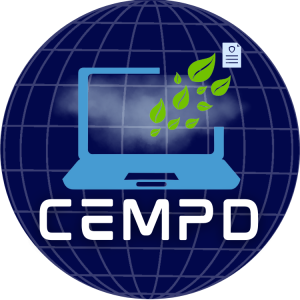Center for Environmental Modeling for Policy Development

The Center for Environmental Modeling for Policy Development (CEMPD) within the Institute is a team of research faculty and scientists with a strong reputation in emissions, meteorology and air quality modeling, and performing interdisciplinary research that connects emissions sources with air quality and health. The Global Burden of Disease (2019) estimates that about 6.7 million people die prematurely due to exposure to air pollution, making it the 4th highest risk factor for human health. CEMPD provides research, development and application expertise in air quality modeling and related applications to federal, state and local agencies, regional planning organizations, private research organizations and corporations, and international entities to address this critical health risk factor.
In addition to being well known as air quality model developers and application experts, CEMPD is credited for creating innovative decision support tools with a strong focus on air quality. As primary or partial developers of multiple tools related to environmental modeling, CEMPD has demonstrated expertise in developing innovative modeling and analytical approaches. CEMPD has expertise in the development and application of emissions, meteorological and air quality models for studying air quality at multiple scales from local to regional to intercontinental. Specifically, this includes capturing the physical and chemical processes at a variety of spatial and temporal scales – from the exhaust of a single combustion source (power plant, aircraft engine, etc.) to street-scale to urban-scale to regional/global scales. Further, the modeling techniques developed range from detailed treatment of all physical and chemical processes as well as reduced-form or reduced-complexity approaches for rapid turn-around of results for screening assessments. CEMPD emphasizes the transfer of knowledge and technology as much as the timely delivery of sound scientific evaluation and well‐documented modeling results.
A flagship project at CEMPD is serving as the host of the EPA-funded Center for the Community Modeling and Analyses System (CMAS), in its 22nd year of operations to serve a global community of nearly 10,000 users.
To find out more about our research portfolio, select from the following focus areas:
- Development of Aviation Air Quality Tools for Airport-Specific Impact Assessment: Air Quality Modeling
- Impacts of the Oil and Gas Emissions Sector on Air Quality and Health
- Zip-code Level Air Quality and Health Impacts Screening Tool for Environmental Policy Evaluation in New York City
- Air Quality Modeling for the Transportation and Climate Initiative (TCI)
- Transportation, Equity, Climate and Health – Assessing the Air Pollution and Health Impacts of Electrical Grid Interactions with the Transportation System
- Green spaces and climate-related heat mortality in Latin American cities
- Air Quality Modeling Assessment Tools (AQMAT) Development
- Quantifying the Health Impacts of Wood and Biomass Use in the U.S.: Review and Evaluation of Emissions from Wood and Biomass
- Air quality and health equity implications of federal medium and heavy-duty vehicle electrification policies in New York City and Atlanta
- Energy System Modeling Activities
- Database and Analyses of Exposure-based PFAS Categories
Development of Aviation Air Quality Tools for Airport-Specific Impact Assessment: Air Quality Modeling
ASCENT – the Aviation Sustainability Center – is a cooperative aviation research organization, also known as the Center of Excellence for Alternative Jet Fuels and Environment, ASCENT is funded by the FAA, NASA, the Department of Defense, Transport Canada, and the Environmental Protection Agency. ASCENT works to create science-based solutions for the aviation industry’s biggest challenges. Since 2013, UNC is part of the coalition of 16 leading U.S. research universities and over 60 private sector stakeholders committed to reducing the environmental impact of aviation. ASCENT also works in partnership with international research programs, federal agencies and national laboratories to create an all-inclusive research capability for whatever environmental impact obstacle the aviation industry faces.
The objective of research at UNC as part of ASCENT Project 19 is to continue developing tools that will enable quantification of National Airspace System-wide and airshed-specific air quality and health impacts due to aircraft emissions in select regions of the country. See more about this at: https://ascent.aero/project/development-of-aviation-air-quality-tools-for-airport-specific-impact-assessment-air-quality-modeling/
Current ongoing tasks under ASCENT19 include:
- Development of a new aircraft-specific dispersion model focused on both physical and chemical processes
- Integrated assessment of aviation contributions to ultrafine particles using a measurement and modeled approach at Boston Logan international airport
- Development of volatilePM plume-scale modeling of aircraft emissions into CMAQ
Sponsored by: U.S. Department of Transportation’s Federal Aviation Administration
Period of Performance: 2013 – Current
Impacts of the Oil and Gas Emissions Sector on Air Quality and Health
The objective of this research is to review, evaluate and refine the emissions inventories due to the oil and gas sector, and use a comprehensive modeling framework based on WRF-SMOKE-CMAQ modeling system to quantify the impacts of this sector on a nation-wide basis on both air quality and health.
Current ongoing tasks include:
- Quantify air quality and health impacts from this sector on a nation-wide basis due to various federal/state policies
- Assess air quality and health impacts due to emissions from the Permian basin
- Assess contributions from this sector’s emissions on potential non-attainment in specific areas of the U.S.
Sponsored by: Environmental Defense Fund
Period of Performance: 2019 – Current
Zip-code Level Air Quality and Health Impacts Screening Tool for Environmental Policy Evaluation in New York City
This research for NYSERDA leverages two existing screening level models that have been independently developed under funding from the U.S. EPA – (a) the Community TOOLS (C-TOOLS) – suite of local-scale air quality tools that are web-based and assess near-source air quality exposures due to various sources. and (b) the CO-Benefits Risk Assessment (COBRA) tool – an open-source software application that estimates the incidence of health effects and the monetary value of those health effects, resulting from changes in ambient concentrations of PM2.5. COBRA currently estimates public health benefits at the county level, using a reduced-form air quality model called the Source- Receptor (S-R) Matrix. The project’s goal is to integrate COBRA and C-TOOLS, and add custom higher resolution input datasets for emissions, health incidences and population for New York City (NYC) to allow for a finer-grained, more localized analysis of the health benefits from air quality management decisions, and perform rapid evaluation of various policy options.
To achieve this goal, our proposed research has the following objectives:
- Enhance C-TOOLS (web-based) and COBRA (desktop application) to use zip-code level inputs for NYC, and county-level for rest of the state;
- Integrate C-TOOLS with COBRA to have a single web-based user interface to perform high resolution ZIP-code level assessments;
- Identify various policy options for NYC and evaluate the health benefits at a high-resolution; and
- Transfer technology to a key end-user for continued assessments and use in the future
Sponsored by: New York State Energy and Research Development Authority
Period of Performance: 2019 – Current
Air Quality Modeling for the Transportation and Climate Initiative (TCI)
The Transportation and Climate Initiative (TCI) is a regional collaboration of 12 Northeast and Mid-Atlantic states and the District of Columbia that seeks to improve transportation, develop the clean energy economy and reduce carbon emissions from the transportation sector. The participating states are: Connecticut, Delaware, Maine, Maryland, Massachusetts, New Hampshire, New Jersey, New York, Pennsylvania, Rhode Island, Vermont, and Virginia. Prior work has shown that focusing on health impacts and how reductions in emissions from transportation emissions can lead to health benefits will provide added value in emissions reductions strategies.
Our goal is to collaborate with the Harvard T. Chan School of Public Health’s C-CHANGE center to quantify these health benefits through detailed air quality modeling. The UNC Institute for the Environment (IE) is currently developing a year 2016 air quality modeling platform that uses emissions from the National Emissions Inventories (NEI). The NEI-2016 is the latest base year estimate that the EPA has developed under a collaborative process with various states, and this also includes projection year emissions for the years 2023 and 2028. The 2016 modeling platform uses a sophisticated modeling framework with a number of enhancements.
These modeling enhancements will be comprehensive (look at both O3 and PM2.5), use a more recent air quality modeling platform, and be able to track air quality (and potentially health) impacts. UNC-IE’s modeling framework will track state-level or multiple counties with select metropolitan areas and emissions precursor species to create a detailed multidimensional source-receptor matrix, and thus providing valuable inputs for decision-making.
We propose to address the following aim in this study.
- Estimate contribution of transportation emissions from each of 12 individual states that are part of the Transportation and Climate Initiative (TCI), and a few select metropolitan areas – to O3 and PM2.5 in downwind states of the U.S. using a sophisticated modeling framework that is based on WRF-SMOKE-CMAQ-DDM-BenMAPR.
Sponsored by: Barr Foundation
Period of Performance: 2019 – 2023
Transportation, Equity, Climate and Health – Assessing the Air Pollution and Health Impacts of Electrical Grid Interactions with the Transportation System
This study leverages the modeling platform created in support of the TCI (described above) to further assess range of transportation strategies, or complementary policies, that states may be considering beyond TCI. UNC previously performed CMAQ-DDM modeling at 12×12-km resolution for a domain covering the Eastern US for a large combination of inputs including individual states and metropolitan areas, precursor emissions and vehicle classes to compute O3 and PM2.5 sensitivities. Further, several policy scenarios under the TCI were also modeled for the future year 2032 and compared against a no-TCI scenario.
Specific aim of this project is to perform CMAQ modeling where we include the effects due to increased load on the electrical grid from the deployment of electrical vehicles (EVs). Specifically, we would perform atmospheric modeling simulations using the CMAQ-DDM framework to assess the direct air pollution and health impacts of changes in electrical grids emissions, and assess how changes in electrical grid emissions interact with changes in transportation emissions to affect air quality and health.
Sponsored by: Energy Foundation
Period of Performance: 2020 – 2023
Green spaces and climate-related heat mortality in Latin American cities
Extreme heat events will increase with climate change, while rising human exposure is likely as the global population further urbanizes. Using an unprecedented urban resident mortality database for nine Latin American countries, UNC is part of a multi-institutional and interdisciplinary research team to examine: a) the impacts of climate change on urban population mortality from increases in the magnitude, duration, and frequency of extreme heat events, and b) the potential protective effect of urban greenspace presence and its spatial configuration. The region’s high level of urbanization, inequality, and varying climates provide opportunities to understand impacts of climate change in urban areas. Using past climate and mortality data, we first estimate the impact of extreme heat events on excess mortality and assess the moderating effects of greenspaces. Then, we downscale two IPCC global climate scenarios to a 36-km resolution (with more refined 12-km downscaling for two areas) and estimate the duration, magnitude, and frequency of heat waves for the mid-21st century. Future population and greenspace presence/configuration scenarios, coupled with estimated heat wave events, will be used to estimate future excess mortality by age and education. This study will provide evidence of health impacts of future heat waves and outline opportunities for mitigation and pro-active involvement.
We will use the Weather Research Forecast to use two approaches to downscale to 12km x 12km two IPCC global climate scenarios representing low and high predicted changes in climate (RCP 2.6 and RCP8.5) for 2001-2010 (as baseline) and for midcentury (2045-2055) to estimate the duration, magnitude, and frequency of the future heat waves. Scenarios of population and greenspace presence and configuration (size, concentration, and spatial distribution pattern), coupled with future heat wave events, will be used to estimate excess mortality by age and education.
Sponsored by: Wellcome Trust
Period of Performance: 2020 – 2023
Air Quality Modeling Assessment Tools (AQMAT) Development
The overall objective of this project is to assist the EPA in developing and upgrading a suite of Air Quality Modeling Assessment Tools (AQMAT) for supporting regulatory modeling efforts.
Specific goals are to support the development and improvement of
- Flexible Air quality Scenario Tool – Community Edition (FAST-CE) Tool
- NEXUS Multi-Pollutant Analysis Tool
- Existing Air Quality Modeling Assessment Tool
Sponsored by: U.S. Environmental Protection Agency (U.S. EPA)
Period of Performance: 2021 – 2024
Quantifying the Health Impacts of Wood and Biomass Use in the U.S.: Review and Evaluation of Emissions from Wood and Biomass
Recent research has revealed that the combustion of wood and biomass for energy has a substantial, and underappreciated, impact on health. Despite regulations on fireplaces and wood stoves, the health impact of residential wood heating remains above 10,000 attributable deaths per year due to fine particle exposure. The impact of biomass use, especially in industry, has grown dramatically over the last decade, potentially due to its designation as a carbon-neutral fuel, and also has a public health burden of over 10,000 attributable deaths annually.
In this multi-phase study, we will achieve the following objectives:
- Review and Evaluation of Emissions from Wood and Biomass
- Perform a State Case Study for Biomass Energy
- Perform a Nationwide Assessment of Impacts of Biomass
The health impacts of the use of wood and biomass for energy have been underappreciated, and as a consequence, understanding the magnitudes of emissions data has been neglected. We propose to review and compile existing data on biomass fuel use and emissions to build a nationwide emissions inventory for wood and biomass use that has emissions broken down by specific fuel type (firewood, wood pellets, agricultural waste, and others) and sector and use type (residential wood use in fireplaces and wood stoves, industrial use for energy, electricity generation, etc.).
Sponsored by: National Wildlife Federation
Period of Performance: 2021 – 2023
Air quality and health equity implications of federal medium and heavy-duty vehicle electrification policies in New York City and Atlanta
The objective of this research is to use a reduced form dispersion tool (ZIP Code-Level Air Pollution Policy Assessment (ZAPPA) tool, which currently relies on dispersion estimates of Primary PM2.5 from C-TOOLS combined with fine scale health assessment (BenMAPR) to quantify the contribution of different classes of vehicles to air pollution health impacts and policy benefits across the city at a census tract scale. While ZAPPA can currently treat PM2.5 (primary from dispersion and secondary from reduced form approaches as used in COBRA and other reduced complexity models like EASIUR), we will enhance ZAPPA to account for dispersion of NOx and implement the NOx to NO2 conversion to provide estimates of changes in NO2 exposure.
Currently, ZAPPA uses the NEI 2016 v1 modeling platform-based inventories that are augmented with road network and activity data provided by the New York City Department of Health. While ZAPPA is nearly implemented for New York City, we will build ZAPPA for Atlanta as part of this study. We will rely on input datasets such as the road network and vehicular activity from the Atlanta Regional Commission to be able to support the fine-scale modeling.
UNC-IE will use ZAPPA’s C-TOOLS dispersion model to predict annual average PM2.5 and NO2 from the on-road transportation sector at ZIP code resolution and focus on incremental changes due to the policy options. The ultimate objectives are to look at the distribution of health impacts due to the fleet electrification in these cities.
Sponsored by: Environmental Defense Fund
Period of Performance: 2021 – Current
Energy System Modeling Activities
The U.S. EPA has developed a tool called COMET (City-based Optimization Model for Energy Technologies) that facilitates urban scale analysis of integrated strategies for energy planning that considers costs and emissions implications of technology pathways meeting energy demands in buildings and transportation sectors. First application of COMET was piloted in NYC, and was built on the MARKAL (MARKet ALlocation) optimization framework. ZAPPA-NYC is another health impacts assessment tool used to estimate public health benefits of adopting clean and renewable energy and reducing energy demand in both New York City and counties throughout the states. The goal of this project is to provide support to the EPA for updates to COMET, develop applications of the tool, and link the tools with health benefits calculators to provide in-depth cumulative impacts of climate mitigation actions on the energy sector at a local scale. Specifically, UNC’s role is to develop a scenario framework to link results from COMET-NYC with ZAPPA-NYC, and utilize COMET-NYC scenarios utilized in a previous study that previously evaluated transportation decarbonization pathways for NYC.
Sponsored by: U.S. Environmental Protection Agency (U.S. EPA)
Period of Performance: 2022 – 2025
Database and Analyses of Exposure-based PFAS Categories
Overall, this research will enable EPA-funded researchers and collaborators to integrate their per- and poly-fluoroalkyl substances (PFAS) exposure data by developing a database system and web-accessible tool to house harmonized (deidentified) environmental occurrence, questionnaire, and biomarker data from PFAS studies. This resource will promote secondary analysis of pooled PFAS exposure data, explore relationships between PFAS measured in multiple media including air, and facilitate development of exposure-based categories.
Specific goals are to:
1) Develop a secure database and associated computational pipelines for EPA and collaborating research community focused on characterizing PFAS human exposure.
2) Leverage human exposure research and data science tools to develop exposure-based categories (classes) for PFAS based on occurrence patterns in environmental and biological media.
3) Advance understanding of human exposure to PFAS by providing the data researchers need to:
- Identify, characterize, and predict important human exposure sources and pathways
- Evaluate the contribution of these exposure sources/pathways to PFAS body burdens
- Prioritize efficient and effective collection of PFAS exposure information and anticipate exposures to new PFAS.
Sponsored by: U.S. Environmental Protection Agency (U.S. EPA)
Period of Performance: 2023 – 2026
Rocky Mountain Atmospheric Nitrogen and Sulfur Study
CEMPD is working with the National Park Service Air Resources Division to study the causes of haze and acid deposition in Rocky Mountain National Park. As a participant in the Rocky Mountain Atmospheric Nitrogen and Sulfur (RoMANS) study, we are furthering our understanding of the origins of emissions currently affecting ecosystems and visibility in the Rocky Mountain region of Colorado and exploring how emissions controls or reduction strategies can help mitigate pollution effects.
Sponsored by: National Park Service (NPS)
Western Regional Air Partnership Regional Modeling Center
As the lead of the emissions modeling effort for the WRAP RMC, CEMPD supported regional haze SIP development for states in the Western U.S. We provided technical and regulatory guidance on emissions sources, data, and modeling systems to the WRAP states and tribes as they prepared regional haze SIPs.
Sponsored by: Western Regional Air Partnership (WRAP)
Verdi
The Visualization Environment for Rich Data Interpretation (VERDI) tool is an open-source Java tool for visualizing the results from the Community Multi-scale Air Quality Model (CMAQ), associated programs and other environmental data. Learn more
Sponsored by: United State Environmental Protection Agency (U.S. EPA)
Spatial Allocator
The Spatial Allocator (SA) is a set of tools that helps users process and generate geospatial data files related to SMOKE emission, WRF meterology, and CMAQ air quality modeling. The tools are designed to compute surrogate files needed in SMOKE, BELD3 data for BEIS biogenic modeling, surf zone data needed in CMAQ sea salt emission estimate, and NLCD/MODIS land cover data for WRF/CMAQ land surface flux and depostion modeling. It also contains some simple geospatial data overlay and allocation processores which are generally used.
Sponsored by: United State Environmental Protection Agency (U.S. EPA)
UNC Spatial Allocator Version 3.6 (3/12/2009)
The Spatial Allocator (SA) is a set of tools that helps users manipulate and generate data files related to emissions and air quality modeling. The tools perform functions similar to Geographic Information Systems, but are provided to the modeling community free of charge. In addition, the tools are designed to support some of the unique aspects of the file formats used for Community Multiscale Air Quality (CMAQ) and Sparse Matrix Operator Kernel Emissions (SMOKE) modeling.
The MIMS Spatial Allocator is licensed as open-source software and provided at no cost because its development was sponsored by NOAA and EPA. The Spatial Allocator uses GIS industry standard ESRI shapefiles, image files, netCDF files and plain text data files as input and output data. The Vector Tools and Raster Tools components of the Spatial Allocator are written in the highly portable C and C++ programming language. The surrogate tools used to run the utilities for all surrogate computation and quality assurance summary tables are written in Java programming language. The current release of the Vector Tools and Raster Tools provides binaries built on a 32-bit Red HAt Linux operating system. In addition to the supported operating systems, the Spatial Allocator can easily be adapted to run on almost any UNIX-based operating system, as source code is provided. Because the Surrogate Tools are written in Java they are provided in a java archive (.jar file) that can be used on any computer for which Java 1.5 or later is installed.
The Spatial Allocator uses PROJ4.6 to project betweeen spherical earth R and ellipsoids. PROJ4.6 uses no datum transformation, matching the WRF and MM5 projections. Earlier versions of the spatial allocator used PROJ4.5 or earlier, which performed datum transformations automatically and resulted in mismatches.
- Vector SA uses: I/O API and NetCDF libraries compiled using pgcc, but PROJ4 compiled with gcc.
- Raster SA uses: PROJ4, NetCDF, and GDAL compiled with gccInstructions for downloading and installing.The official location for downloading the tools programs is from www.cmascenter.org. You should register as a user if you have not already and go to the DOWNLOAD CENTER shown on the left portion of the page. Choose Spatial Allocator for the model family to download.
- Vector Tools (html): The Vector Tools allow you to develop individual spatial surrogates, to change the map projection of Shapefiles, to remap spatial data from one spatial domain to another (e.g. counties to grids, fine grids to coarse grids), and to perform other types of spatial manipulation without using a GIS.
- Raster Tools (html): The Raster Tools allow you to manipulate raster data such as the NLCD, and to summarize raster data to counties or other geopolitical boundaries.
- Surrogate Tools (html): The Surrogate Tools allow you to manage the creation of large sets of spatial surrogates and also supports merging and gapfilling of surrogates.
Control Strategy Tool (CoST)
Objectives include:
* Support the preparation and analysis of future year emission control strategies for point, area, and mobile sources;
* Track information on control measures, their costs, and the emission sources to which they apply;
* Facilitate multi-pollutant analyses, including criteria pollutants and their precursors, HAPs, and greenhouse gases.
Sponsored by: United State Environmental Protection Agency (U.S. EPA)
Education is an integral part of CEMPD’s mission. Our education program encompasses professional training courses on operational atmospheric modeling, conferences that convene environmental scientists from around the world, undergraduate and graduate level university courses, and technical support for air quality modeling. Global in scope, our education program recognizes that air quality issues must be addressed on an international scale. The objective of our education program is to create a global workforce skilled in a common framework for studying and discussing air quality issues.
CMAS Training
The air quality modeling training program at CEMPD has trained hundreds of scientists throughout the world on how to use meteorology, emissions, chemistry-transport, and benefit models for studying air pollution formation, transport and health impact. With over a decade of experience in teaching classes worldwide, CEMPD trainers are internationally recognized as leaders in the field of operational training for air quality and emissions modeling. From standardized introductory hands-on modeling courses to customized visiting scientist programs, CEPMD offers a range of educational opportunities for all levels of air quality scientists. Learn more
Conferences
The annual CMAS Conference brings together hundreds of atmospheric scientists from around the world to discuss current and emerging issues in air quality modeling and analysis. Our speciality workshops gather targeted groups from the atmospheric science community to advance the state of the science through collaborative research and education. Learn more
International Reach
As internationally recognized experts in meteorology, emissions, and air quality modeling, our scientists travel the globe teaching short courses and workshops. Our in-house training program also draws scientists from around the world to engage in our collaborative approach to learning. Learn more
UNC-Chapel Hill Courses
Our scientists teach undergraduate and graduate level courses at the University of North Carolina through the Environmental Studies and Environmental Sciences curricula. We also provide guest lectures on atmospheric science to several other departments on campus. Learn more
Modeling Support
As the host of the CMAS Center we are the central clearinghouse for air quality modeling software, data, and technical support. Our web-based help desk and email listservs connect the global atmospheric science community to experts in meteorology, emissions, and air quality modeling and analysis. Learn more
Visiting Scientist Program
Our Visiting Scientist Program presents customized educational opportunities and provides a collaborative context for experienced atmospheric scientists to visit CEMPD and work with our training and research staff for extended periods. Ranging from a week to several months, this Program is designed on a case-by-case basis to engage our scientists in specific research questions presented by visiting members of the air quality modeling community. Learn more
 GSA Environmental Consulting
GSA Environmental Consulting
Professional Service Schedule: 899 1-Environmental Consulting Services
Contract: 47QRAA18D00CA
The UNC IE Advantage!
As a recognized environmental consultant, the UNC Institute for the Environment (IE) is leading UNC’s world‐renowned environmental community in developing solutions to these critical challenges. In doing so, it educates future environmental leaders and engages with the people of North Carolina and the nation to address and solve environmental challenges. IE’s Center for Environmental Modeling for Policy Development (CEMPD) is a team of research faculty and scientists with a strong reputation in emissions, meteorology, and air quality modeling.
IE has an infrastructure in place with the Community Modeling and Analysis System (CMAS) Center. Under a cooperative agreement and earlier contracts with U.S. Environmental Protection Agency, the University of North Carolina’s Institute for the Environment has hosted the CMAS Center since 2001. IE performs CMAS activities within four main components: emissions and air quality model development, research and applications, user support and training, and outreach for the broader stakeholder community. IE has ongoing and active support for the EPA’s Office of Research and Development (ORD) and Office of Air Quality Planning and Standards (OAQPS), besides other federal agencies including the National Oceanic and Atmospheric Administration (NOAA), Department of Transportation’s Federal Aviation Administration (FAA) and the Federal HighWay Administration (FHWA) among others.
UNC IE | GSA Price List: Download price list
Period of Performance: July 15, 2018 through July 14, 2023
Contacts
Deputy Director & Research Professor
UNC Institute for the Environment
100 Europa Dr., Suite 490
Chapel Hill, NC27517
P: (919) 966-2126
sarav@email.unc.edu
Executive Director
Office of Sponsored Research
104 Airport Drive Suite 2200
Chapel Hill, NC 27599-1350
P: (919) 966-3411
Fax (919) 962-5011
gsaosr@unc.edu
 To learn more about UNC IE’s services visit GSA Advantage! http://www.gsaadvantage.gov or here about IE’s contract: 47QRAA18D00CA.
To learn more about UNC IE’s services visit GSA Advantage! http://www.gsaadvantage.gov or here about IE’s contract: 47QRAA18D00CA.
- Advanced Modeling System for Forecasting Regional Development, Travel Behavior, and the Spatial Pattern of Emissions
- National Strategy for Environment and Health for the United Arab Emirates
- Variable Grid Modeling
- Storm surge prediction
- Data Assimilation
- Hemispheric CMAQ
- Integrating satellite data with ground-based data
- Effects of Climate Change on Human Health in North Carolina
- Air Quality Impacts of Aviation Emissions
- Air Quality Forecasting to Develop Guidance for Quantifying the Contribution of Airport Emissions to Local Air Quality
Advanced Modeling System for Forecasting Regional Development, Travel Behavior, and the Spatial Pattern of Emissions
Through simulation modeling of land use, transportation, emissions, and air quality, this project funded by the U.S. EPA will determine whether regional development patterns, and market and non-market policy instruments to influence such patterns, can significantly influence the spatial characteristics and quantity of emissions that contribute to tropospheric ozone and fine particulate matter. The fundamental goal of our research which is a joint effort between the UNC Department of City and Regional Planning, Center for Urban and Regional Studies, Institute for the Environment and North Carolina State University, is to rigorously test the hypothesis that alternative development patterns, over a planning horizon of 50 years, can significantly influence the quantity and location of direct and indirect emissions from mobile sources (and hence reduce the levels of tropospheric ozone and fine particulate matter (PM)). The development patterns of interest include the type of development (transit-oriented and dense mixed-use developments, and those supportive of non-motorized transportation modes for non-work trips, etc.) and its location (neo-traditional suburban, new urban core development, redevelopment, etc.). The enhanced link-based emissions inventories developed for Mecklenburg county, NC were then used in the MM5-SMOKE-CMAQ modeling system to study potential improvements in characterization of emissions and then air quality in the region.
Sponsored by: U.S. Environmental Protection Agency (U.S. EPA)
National Strategy for Environment and Health for the United Arab Emirates (UAE)
Two-year project sponsored by the Environment Agency, Abu Dhabi to provide a comprehensive environmental burden-of-disease assessment for the United Arab Emirates (UAE). CEMPD is conducting research for the ambient air quality component of this study. Our first air quality simulations using the WRF/SMOKE/CMAQ models are helping to quantify current concentrations of air pollutants in the UAE. Following this, we will continue to enhance and apply the models to provide a framework for informing policy and regulatory decisions regarding air quality in the UAE and the Middle East region.
Sponsored by: Environment Agency, Abu Dhabi
Variable Grid Modeling
An innovative air quality modeling technique that alleviates many of the shortcomings of the traditionally used nested regular-grid modeling approach, in particular related to biases near boundaries and the excessive computational requirements when using nested grids.
Models and Processes: SMOKE-VGR, MAQSIP-VGR, CMAQ-VGR
Sponsored by: United States Environmental Protection Agency (U.S. EPA)
OLAS Storm Surge Prediction Testbed
A real-time, event-triggered storm surge prediction system has been developed to assist emergency managers, policy-makers and other government officials with evacuation planning, decision-making and resource deployment during tropical storm landfall events. A rapid response assessment of hurricane threat is accomplished by driving the ADCIRC (Advanced Circulation) storm surge model with winds from an asymmetric gradient wind vortex model generated from the National Hurricane Center (NHC) forecast advisories the moment they are inserted into the real-time weather data stream, thereby maximizing the number of hours of forecast utility.
Sponsored by: United States Environmental Protection Agency (U.S. EPA)
LEAD – A New Approach for using Web Services, Computational Grids and Virtual Organizations in Mesoscale Meteorological Research and Forecasting
Linked Environments for Atmospheric Discovery (LEAD) is a National Science Foundation (NSF) Large Information Technology Research (ITR) grant that has pioneered new approaches for integrating complex weather data, assimilation, modeling, data-mining, and cyberinfrastructure systems. By managing the complexity of inter-operative cyber tools and providing flexibility and ease in how they can be linked, LEAD allows users to focus their time on solving the science and engineering problems at hand, providing a means for more deeply understanding the tools and techniques being applied rather than the nuances of data formats, communication protocols, and job execution environments.
Sponsored by: National Science Foundation (NSF)
Hemispheric Air Quality Simulations With CMAQ
CEMPD created a prototype of performing hemispheric air quality simulations with CMAQ. The first part of this study is to apply the Weather Research and Forecasting Model (WRF), Version 3, to a Northern Hemisphere (NH) domain. The reason for this study, is that current applications of CMAQ over North America as a limited geographic domain require lateral boundary conditions. Having WRF and CMAQ on the NH will provide a consistent set of boundary conditions for limited domain runs.
Sponsored by: United States Environmental Protection Agency (U.S. EPA)
Improving an Air Quality Decision Support System Through the Integration of Satellite Data with Ground-based, Emissions and Modeled Data
To improve air quality decision-making by local, regional, and national planners, this project is integrating key NASA satellite data to augment relevant databases, improve air quality simulation models, and enhance the analytical capabilities of the VIEWS/TSS decision support system used by Federal, regional, state, tribal, and local agencies. The CEMPD team is joined on this 3-year effort with the Cooperative Institute on Research in the Atmosphere, the Joint Center for Earth Systems Technology at the University of Maryland – Baltimore County, and UNC’s Renaissance Computing Institute under funding from the NASA Research Opportunities in Space and Earth Sciences (ROSES).
Sponsored by: National Aeronautics and Space Administration (NASA)
Effects of Climate Change on Human Health in North Carolina: Current and Future Impacts
CEMPD scientists are analyzing climate trends and the associated weather in terms of eight identified air-mass/weather types for a number of cities in North Carolina. We hypothesize that such air masses and the corresponding air quality conditions will have differing health impacts on humans, which can be quantified based on statistical analyses of the correlates among the meteorological, climate, air quality, and health data.
Sponsored by: United States Environmental Protection Agency (U.S. EPA)
Air Quality Impacts of Aviation Emissions
CEMPD is a member institution of PARTNER – Partnership for AiR Transportation Noise and Emissions Reduction – a leading aviation cooperative research organization, and an FAA/NASA/Transport Canada-sponsored Center of Excellence. Under this project, CEMPD scientists are quantifying the potential incremental contribution of aviation emissions to air quality though their interaction with the background air. Towards this objective, we are developing and refining tools and analyses to model aviation emissions at multiple scales – from plume-scale to local-scale to regional-scale to study aviation impacts on air quality using state-of-the art modeling tools that incorporate one-atmosphere treatment for ozone, particulate matter and hazardous air pollutants. The research carried out under this project will exchange information with other PARTNER projects on emissions and health impacts.
Sponsored by: Federal Aviation Administration (FAA)
Air Quality Forecasting to Develop Guidance for Quantifying the Contribution of Airport Emissions to Local Air Quality
Under funding from the Transportation Research Board of the National Academies, CEMPD is developing a near real-time air quality forecast system for the Washington-Dulles International Airport using the WRF-SMOKE-CMAQ modeling system. The objective of this research project is to provide guidance for airport operators on effective tools and techniques for measuring airport contributions to ambient air quality. The research will evaluate existing and potential monitoring strategies and forecasting techniques that airport operators can use to measure airport-related air quality impacts on local jurisdictions that may exceed what is traditionally measured and modeled for National Environmental Policy Act (NEPA) purposes. The goal of the air quality forecast is to help with a multi-season field campaign at the Dulles airport to characterize the relative contribution of Dulles airport to local and regional air quality in comparison to non-airport emission sources, and evaluate the source-based and receptor-based modeling approaches with field measurements.
Sponsored by: Transportation Research Board of the National Academies
CMAS Center
The EPA-funded Center for Community Air Quality Modeling and Analysis, founded in 2001, has been hosted at Carolina since 2003 and works with the agency to lead the international, open-source, community-based air quality modeling and analysis software used to evaluate and propose regulations. The extended funding allows the center to continue and expand the scope of its work in these vital environmental and human health areas.
Since its inception, the center’s environmental and air quality models, have been used by regulatory offices at the EPA, as well as state governments, academics, businesses, industries, federal agencies and the international community. It has grown to serve more than 5,000 registered users in more than 90 countries.
Meet the Team

Sarav Arunachalam
Deputy Director, Institute for the Environment
Director, Center for Environmental Modeling for Policy Development
(919) 966-2126

Sedona Ryan
Research Coordinator, Center for Environmental Modeling for Policy Development
sedryan@unc.edu(919) 966-1352

Elizabeth Adams
Research Associate, Center for Environmental Modeling for Policy Development
lizadams@email.unc.edu(919) 678-1513

Bin Cheng
Research Associate, Center for Environmental Modeling for Policy Development
bincheng@unc.edu
Hyeongseok (Darby) Kim
Graduate Research Assistant, Center for Environmental Modeling for Policy Development
kkkghs@unc.edu(984) 528-6510

Gavendra Pandey
Research Associate, Center for Environmental Modeling for Policy Development
gavendra@email.unc.eduCatherine Seppanen
Research Associate, Center for Environmental Modeling for Policy Development
cseppan@email.unc.edu(919) 966-2249

Manish Soni
Post-Doctoral Research Associate, Center for Environmental Modeling for Policy Development
manisoni@unc.edu(646) 387-6264

Huy Tran
Research Associate, Center for Environmental Modeling for Policy Development
tranhuy@email.unc.edu
Carlie J. Coats, Jr.
Senior Software Engineer, Center for Environmental Modeling for Policy Development
cjcoats@email.unc.edu(919) 493-7695
Publications
View the Center for Environmental Modeling for Policy Development’s publications on Google Scholar.
Latest News

New study quantifies health impacts from oil and gas flaring in U.S. (EurekAlert | Mar. 12, 2024)
The study finds that pollution from oil and gas venting and flaring results in $7.4 billion in healt…
Read More
New study quantifies health impacts from oil and gas flaring in U.S.
New study finds pollution from oil and gas flaring results in $7.4 billion in health damages.
Read More
